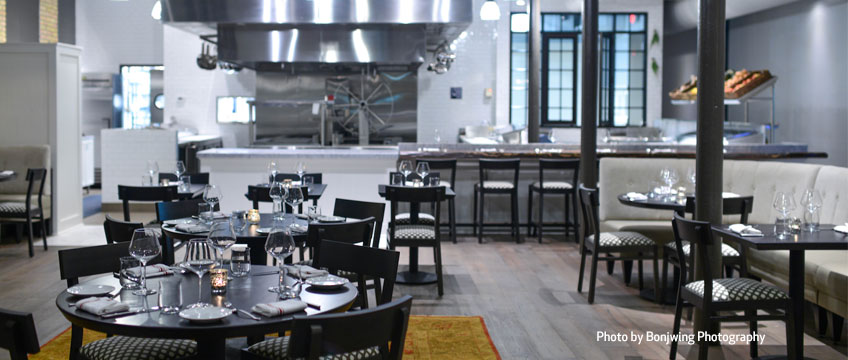An immensely popular new eatery in Minneapolis’ North Loop offers diners a cozy connection with the kitchen
By Joel Hoekstra
Chef Gavin Kaysen was coming home. After 16 years of living outside of Minnesota, the Bloomington native and award-winning chef had decided to open a restaurant in Minneapolis’ North Loop neighborhood. Local foodies imagined Kaysen, a protégé of Daniel Boulud and winner of Food & Wine’s Best New Chef award, serving fancy food in a trendy space. But Kaysen himself longed for a place that felt casual and comfortable. “I really wanted an extension of my home,” he says. “I wanted a kitchen that was open so I could cook, plate, and present the food while talking to my guests. I’ve always cooked that way.”
Last fall, Kaysen welcomed his first guests to Spoon and Stable, a nearly 6,000-square-foot space with a zinc-topped bar, two-story wine room, open kitchen, and menu stuffed with locally sourced ingredients and fascinating preparations. The interiors, designed by Minneapolis firm Shea, exude an elegant informality that mirrors the food: A rack of wool blankets stands near the door, ready to keep sidewalk diners warm on cool fall nights; the 75-seat dining room rings an oriental rug, just like you’d find in an old aunt’s dining room. The colors, textures, and forms of the space are a blend of “industrial and sophisticated, tailored and untailored,” says Shea’s owner and namesake David Shea.
Specializing in hospitality and retail design, Shea prides itself on integrating all aspects of the dining experience, developing everything from logo design and naming to wine-program recommendations and budget development. For Kaysen, the firm even scouted real estate. “The concept didn’t seem like a downtown restaurant, or a suburban restaurant, or a neighborhood restaurant,” says Shea principal Tanya Spaulding. “It seemed like an edge-of-downtown restaurant. North Loop was the right choice.” The firm and the chef ultimately settled on a long and narrow space constructed as a stable in 1906 but converted into a cubicle farm in the recent past.
Kaysen fell in love with it. “It had amazing bones, and the charm was incredible,” the chef says, referring to the brick walls of the two-story space and the old skylights that flooded the interior with daylight. “I knew it should be a restaurant right away.”
Few traces of the building’s days as a working stable remained, but the Shea team built on the structure’s history as it developed the restaurant’s name and interiors. Exposed brick walls became the backdrop for the dining experience. A small original window became the motif for the glass panes in the wine room that towers over the dining room. Wine lists were clad in handcrafted leather covers. “It was great to be able to use the existing structure both physically and as inspiration,” says Shea vice president Jim Ruckle, AIA.
Diners experience the Spoon and Stable space as theater—almost right from the start, says David Shea. The facade is narrow and painted black, with a steel canopy over the door. But inside visitors discover a light-filled, high-ceilinged space with open sightlines from the bar in the front of the house to the kitchen in the back. Anyone can watch as the food makes its way up the modified French line, going through multiple preparations until it reaches Kaysen for approval. “We think of it as a thrust stage,” says Spaulding. “It extends out into the dining room.”
The palette of brick, wood, white marble, and light gray paint is punctuated in several places with personal touches: A table of reclaimed wood made by Kaysen’s brother sits in the entry space, and dozens of spoons collected by Kaysen from restaurants across the country are displayed on the wall. Such homespun elements reinforce the sense of comfort the chef wanted to achieve.
Kaysen says he’s delighted with the restaurant’s reception. The tables are packed every night, and many patrons comment on the decor. “I’ve had people say, ‘I wish I could live here!’” says Kaysen. “There’s really no better compliment than that.”
SPOON AND STABLE
Location: Minneapolis, Minnesota
Client: Gavin Kaysen
Designer: Shea, Inc.
sheadesign.com
Principal-in-charge: David Shea
Project lead designer: Cori Kuechenmeister
Project architect: Jim Ruckle, AIA
General contractor: Zeman Construction
Size: 5,990 square feet
Completion: November 2014


